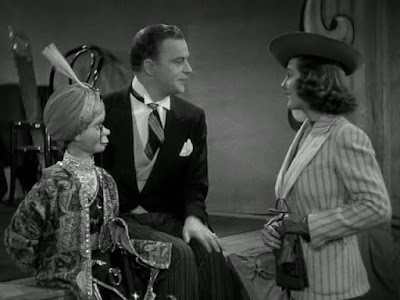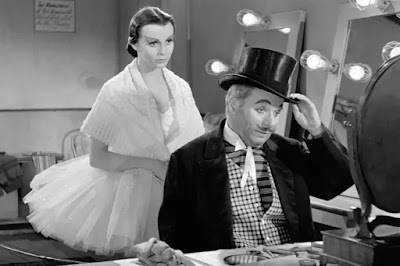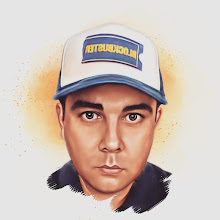"
You Can't Cheat An Honest Man"
*** 1\2 (out of ****)
As noted by the late former Chicago Sun-Times movie critic, Roger Ebert, "W.C. Fields is the most improbable star in the first century of the movies". Born William Claude Dukenfield in 1890 - W.C. Fields created an utterly unwholesome yet undeniably funny comedic persona of a drunkard, who long before Rodney Dangerfield, never got any respect. His characters were often in loveless marriages with nagging wives and disrespectful children. He hated animals and preferred not to work a day in his life. He was a big idea man, always searching for the next get rich quick scheme. And yet, despite Hollywood's strict moral guidelines, his characters succeeded.
"You Can't Cheat An Honest Man" (1939) isn't a great W.C. Fields comedy partly because it doesn't focus exclusively on Fields' persona a la "It's A Gift" (1934) but it does showcase many of the typical Fields traits that made the character so endurable to Depression era American audiences.
In the film Fields plays Larson E. Whipsnade - a dishonest circus owner on the run from the law for non payments of debt. Not only are creditors after him but his own employees are dissatisfied with him for not paying their salaries as well. One of the circus acts includes a ventriloquist, The Great Edgar (Edgar Bergen) and his dummy, Charlie McCarthy (credited as playing himself!). They - or he - hasn't been paid either. At the insistence of Charlie, Edgar is contemplating leaving the circus. Those plans are put on halt when Edgar meets Larson's daughter, Victoria (Constance Moore) and Cupid strikes.
Victoria however hasn't just come to pay dear old dad a friendly visit. She is being pursued by a wealthy, stuff shirt gentleman, Roger Bel-Goodie (James Bush). She doesn't love him and on numerous occasions has turned down his marriage proposals much to the irritation of her brother, Phineas (John Arledge). According to Phineas his sister is throwing away a fortune. What does it matter if she doesn't love him! Victoria accuses her brother of only thinking of himself - a cushy bank job might be offered to him - but perhaps in an attempt to lay on the guilt, Phineas pleads with Victoria, if she won't get married for his sake, think of dad, who is in a financial burden. And so it is the case of the age old question - to marry for love or money? What's a girl to do? In order to confirm Phineas' statement, Victoria decides to visit the circus.
The story by "Charles Bogle" - a pseudonym for Fields - doesn't take this plot serious and understands the story is merely a string to hang a series of jokes on. There is no great chemistry between Edgar and Victoria. There are no scenes were we see romance bloom between them. There are no clear signs Victoria is even in love with Edgar. "You Can't Cheat An Honest Man" doesn't even properly sets-up this Depression era concept by having both men actively compete against each other for Victoria's hand.

The primary function of the movie was to capitalize on a popular "radio feud" between W.C. Fields and Charlie McCarthy, which began in 1937 on the radio program "The Chase and Sanborn Hour". The feud helped re-establish Fields, who had fallen on hard times due to ill-health (the heavy drinking wasn't limited to his on-screen characters). To this day the feud remains one of Fields' career highlights. Some claim however "You Can't Cheat An Honest Man" never fully captured the chemistry Fields and Bergen had on the radio.
It's easy to understand how that could be. On radio Fields, Bergen and McCarthy could trade barbs for 10 minutes and get plenty of laughs and be entertaining. Radio, after all, is a purely audio medium. You couldn't get away with that on film. "You Can't Cheat An Honest Man" has to create sequences exclusively focused on either Fields or Bergen and McCarthy, to allow each man the opportunity to engage in their comedy style and then bring the two sides together. But "You Can't Cheat An Honest Man" never gives us minutes long battles of the wits between Fields and McCarthy as that would be too "theatrical" for film. Only Abbott & Costello it seems could get away with doing radio routines on film. For me however the movie provides a nice balance between the two men's comedy styles. Aficionados of either Fields or Bergen can find something to enjoy.
You can make the case "You Can't Cheat An Honest Man" is as much an "Edger Bergen / Charlie McCarthy comedy" as it is a "W.C. Fields comedy". Edgar Bergen - a fellow Chicagoan - may not be very well remembered today but he was at one time the most famous ventriloquist in America! His decades long career included stops in vaudeville, television, movies and radio. In fact his radio program - "The Edgar Bergen - Charlie McCarthy Show" was rated the most popular radio show in 1937 - 1940 and again in 1942 - 1943. Practically throughout its entire run - which ended in 1957 - it was one of the highest rated shows. That's a heck of a feat when you consider at the same time comedians like Jack Benny, Bob Hope and Red Skelton all had shows. Bergen - and his famous dummies including Mortimer Snerd - appeared in several comedy shorts and feature films like "Charlie McCarthy, Detective" (1939), "Look Who's Laughing" (1941), "Here We Go Again" (1942) and "The Goldwyn Follies" (1938) - which features the last musical score George Gershwin would work on before his death. Bergen also inspired generations of ventriloquists that came after him like Paul Winchell - another forgotten name in comedy - and Shari Lewis.
Bergen and Charlie McCarthy do have some funny moments in the movie like their introductory scene where Bergen as The Great Edgar tries to perform a disappearing act with his assistant McCarthy. The joke being the mischievous McCarthy purposely causes their act to go haywire by never allowing Bergen to properly complete a magic trick. This leads to a re-occurring gag involving Mortimer Snerd who never quite understands why he appears in a scene when he does. He repeatedly confesses to Bergen, it was all Charlie's idea. These moments between Bergen and McCarthy show them at their best. None of their interactions with Fields by comparison are ever quite as funny.
And can we take a moment to discuss Charlie McCarthy? On one hand the movie acknowledges McCarthy is a dummy as Bergen gives an explanation on how ventriloquism works. And yet there are moments when the movie wants us to believe McCarthy is a real person. We see him talk and move without the assistance of Bergen behind them. I've never been quite able to figure out if McCarthy was supposed to be teenager or a bit older. McCarthy however always has his mind on chasing ladies. It makes me laugh but what a strange persona for a puppet. It has become the standard persona all ventriloquists would apply to their own dummies. The dummies often say the things polite society would never say out loud.

Whereas Bergen and McCarthy are funniest when by themselves, Fields on the other hand is consistently funny throughout the movie. Much of the movie seems tailored around the Fields persona. Some of his best moments include when he meets the Bel-Goodie family. To the extent "You Can't Cheat An Honest Man" makes any commentary, it would involve class with Fields and his children representing the working class and the Bel-Goodie family representing high society. Their collision resembles a Three Stooges comedy like "Hoi Polloi" (1935). In these scenes Fields plays up his persona of being a foremost authority on any given subject as he pretends to be a big game hunter.
But Fields' annoyance with every other character at the circus is a joy to watch too. His combative nature with a young man (Grady Sutton) he is swindling with a phony apprentice position is funny. Fields flat out tells the young man, I hate you. Of course that doesn't stop Fields from accepting $15 a week from the young man to observe how to run a circus. Fields also has some nice verbal barbs with Eddie "Rochester" Anderson - the "Rochester" is left out of the credits.
It all paints a portrait of a man distrustful of life, a potential victim of their scams and yet he believes he can take advantage of society as summed up by some famous last words of his grandfather - "Never give a sucker an even break or smarten up a chump." This would seem to contrast the movie's title, "You Can't Cheat An Honest Man" - deception and honesty are all mixed together! Initially many of the characters are dishonest - Victoria leads on Roger, Larson is well...Larson, Charlie McCarthy is willing to resort to theft to get his back pay, Edgar lies to McCarthy about his plans, Phineas wants his sister to lie to Roger. And yet everyone learns the importance of honesty by the end of the movie (well maybe except Fields). Are we supposed to think of Oscar Wilde?
Along with Edgar Bergen, W.C. Fields is also a comedy force society has forgotten. Like Jerry Lewis or Woody Allen there is a blurry line between fact and fiction. Where does the screen persona end and the real man begin? But the persona was one that society can always relate to and should never be forgotten. As with so many of the great screen clowns there is pain and sadness just beneath the laughter. Like Chaplin's Tramp, Fields too is a loner. The difference is Fields prefers it that way and yet enjoys the opportunity to brag to a crowd. He engages in polite societal greetings but mutters disparaging remarks immediately. He is seemingly joyful and happy, singing to himself but the words are crass - "I'd rather have two girls at 21 each than one girl at 42!". There is defeat and the illusion of contentment in the character.
Although the movie was released in that most magical of years, 1939 - which saw the release of "Gone with the Wind", "The Wizard of Oz", "Mr. Smith Goes to Washington", "Wuthering Heights" and "Stagecoach" - "You Can't Cheat An Honest Man" isn't really a cinema classic but it succeeds on the strength of Fields and Bergen. At times the movie seems heavily edited but enough laughs remain to entertain audiences.
p.s. - W.C. Fields, like Groucho Marx, spent his film career playing characters with absurd names. While it is fairly easy to catch the joke concerning his character's first name here - Larson E. - a play on the word larceny - the character's last name, Whipsnade may actually draw its inspiration from Whipsnade Zoo in the U.K. The connection may be both a zoo and a circus deal with animals. Though the zoo was in the U.K. a young Fields may have heard about it since his father was born in England.

















